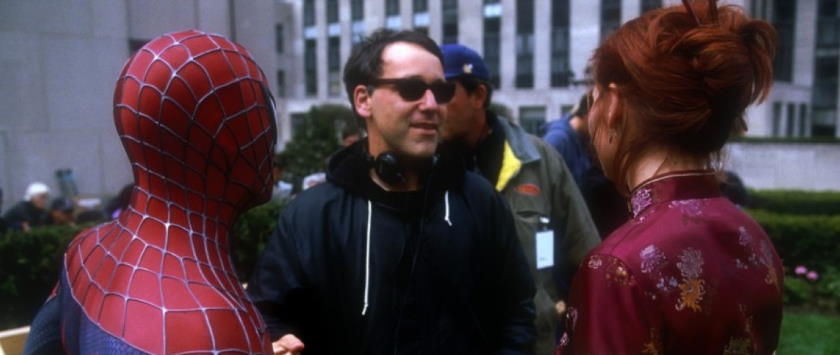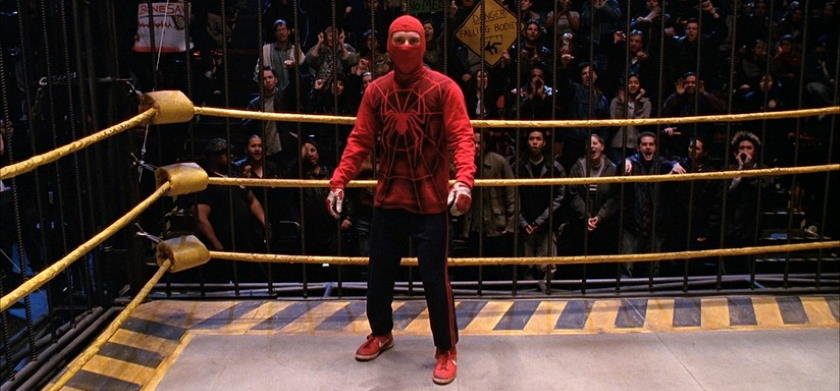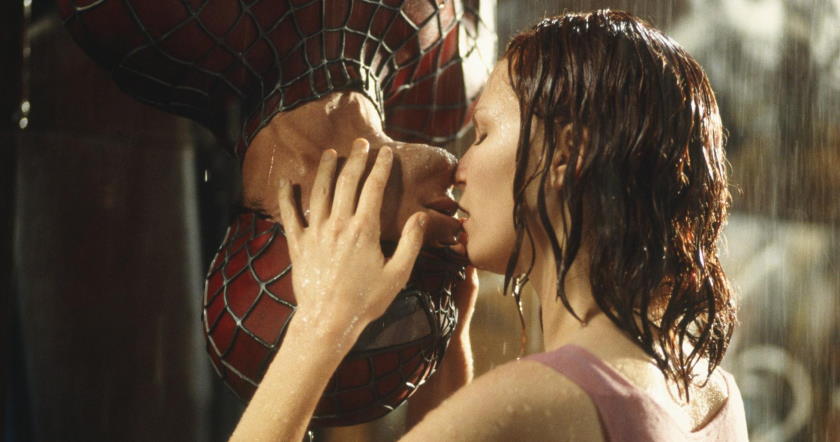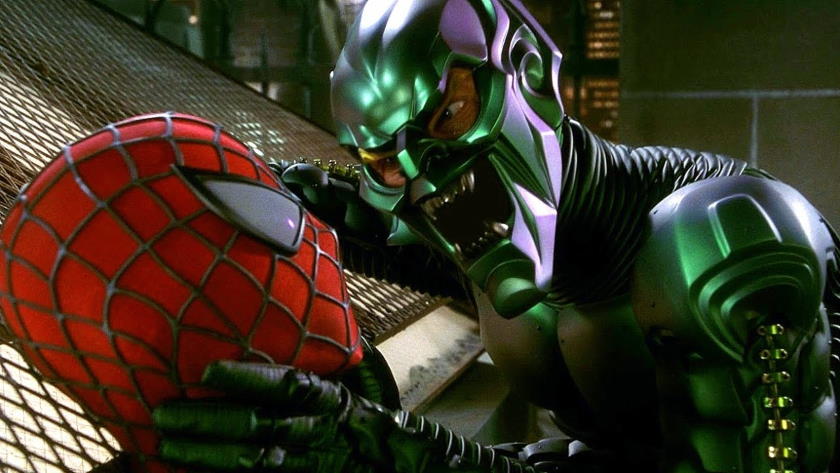Sam Raimi’s Spider-Man is a Spider-Man Film by Sam Raimi

There is a portion of Sam Raimi’s 2002 Spider-Man film that feels like the best theatrical interpretation of the character we’ve ever had. From the moment Uncle Ben is lecturing Peter about how great responsibility comes with great power and, in true teenager fashion, Peter brushes him off. The awkward insistence that Peter be referred to as The Human Spider before being tossed into a ring with Bonesaw, a brutal independent wrestler portrayed by the late and great Macho Man Randy Savage. His refusal to stop a theft after having been screwed over. The sorrowful death of Ben Parker, and the ensuing chase through the city streets as Peter yearns for vengeance. The combination of mourning and unfocused rage as Peter realizes his own inaction led to the demise of his beloved uncle.
It perfectly illustrates what great power and responsibility mean while simultaneously preparing Peter for the hardship he’ll face throughout the rest of the film. You don’t do the right thing for a reward, and failing to do the right thing often leads to the pain and suffering of another. In other words, in true altruistic fashion, doing the right thing means to take the pain and suffering onto oneself rather than allowing it to be inflicted upon others. As Peter begins to save the citizens of New York City, he will find himself celebrated at first, but later hated and rejected.
Of course, you can be forgiven for missing the part where he’s hated and rejected. The Daily Bugle claims citizens are calling for Spider-Man’s arrest, but the magnificent portrayal of J. Jonah Jameson by J. K. Simmons establishes almost immediately that the Daily Bugle is not a reliable, trustworthy source of information. We do receive a scene where police officers try to arrest Spider-Man – not that we really understand why aside from a sudden trust of the Daily Bugle’s accusations – but after that the feelings of New York towards Spider-Man are largely forgotten until the very end, when the film reminds us that the only people that actually love New York City are the poor shlubs that have to live there. Rather than develop on this notion of rejection despite your heroism, the film is far more interested in the drama and love triangle between Harry Osborne, Mary Jane, and Peter Parker.
By far the worst part of the film, and the worst execution of these characters of all the Spider-Man films.
A bold claim, I know, given how rejected the attempted reboot films were with Andrew Garfield. I’m not even sure I feel comfortable claiming Andrew Garfield makes for a good Peter Parker, though he certainly has stronger chemistry with Emma Stone’s Gwen Stacy than Toby Maguire does with Kirsten Dunst. Garfield and Stone have the advantage, of course, of having been an actual couple during the filming of Sony’s two Amazing Spider-Man films, but the failure on Sam Raimi’s part is less the actors and more the writing.
Which theoretically means David Koepp deserves the blame, seeing as he was the screenwriter. According to an interview with Collider, however, David Koepp’s original idea envisioned an entire trilogy featuring Gwen Stacy and her unfortunate demise in the second film. According to the Wikipedia page but not properly cited, Koepp’s script was rewritten by Scott Rosenberg and polished by Alvin Sargent, indicating they’d be the two to blame. However, both Producers and Directors can suggest on-set rewrites and other modifications that dictate the direction of the story.

Peter Parker’s body is most certainly not ready.
So for convenience’s sake, I shall be laying all blame on Sam Raimi, in part because my issues with the characters reflect the old-fashioned style and tone he seems to have gone for. Like Tim Burton’s Batman, Sam Raimi’s Spider-Man is a stylistic and cinematic homage to several prior – one might say vintage – eras and styles of film-making that instantly give it a classic feel. Compared to Bryan Singer’s X-Men, which looks and feels definitively like a 2000 film, Spider-Man feels like a movie out of place in its own time. This is largely due to many of its camera angles, cuts, and visual editing techniques, but also includes lines of dialogue and the campy, “out-of-fashion” atmosphere they help to provide. A young girl excitedly pointing towards the sky and shouting “Look! It’s Spider-Man!” feels ripped right out of a classic superhero cartoon, as does Green Goblin’s frustrated vow of “We’ll meet again, Spider-Man!”, or his threatening “You’ve spun your last web, Spider-Man!” Where Bryan Singer’s X-Men was so embarrassed by the source material’s colorful costumes that it openly mocked them, Sam Raimi embraces the old-fashioned camp and cheese to construct a classic style of superhero film. While X-Men may get a lot of credit for setting the stage for other Marvel films, I believe it was Spider-Man that showed an audience that you could wear your colorful spandex with pride.
The overbearingly dweeby outcast that Peter Parker begins the film as fits into this classic image as well. He feels appropriate for the 50’s or 80’s impression of the “nerd”, stumbling over his words and fawning over the prettiest girl in class. I’m not sure if I had minded the trope back in 2002, though I imagine it is certainly one of the reasons I had grown tired of it by Michael Bay’s Transformers. For years I put all of the blame on how Peter Parker was written – and boy howdy is he such a milquetoast nothing when paired beside Mary Jane that it is maddening – but I think it’s more the complete lack of character of Mary Jane herself.
In my typical self-appointed script doctor fashion, I began to wonder if Mary Jane would have been more interesting if she had already been putting her acting skills to the test in day-to-day life at high school. If, in her heart-to-heart with Peter Parker in their backyard, the abusive screaming of her father from within the house serving as a backdrop to the scene, she confessed to not really liking Flash or the others. She was merely pretending to be “like one of them” in order to survive. It would stand parallel to Peter’s own newly developed Spider-Mask, wearing an artificial smile as an alter-ego at school. It would also contrast Peter’s inability to show his true self to her by being the only person allowed to see her for who she truly is. My goodness, it not only establishes character, but takes advantage of their lives as neighbors and exhibits her trust in Peter not to judge her like she fears the world will.
Instead, Mary Jane simply serves as the pretty young woman for Harry and Peter to passive-aggressively fight over. This robs the film of its other potentially interesting dynamic, which is Norman’s approval and fatherly fawning being given to Peter instead of his own birth son. We witness Harry frequently yearning to be perceived as his own man to his peers while simultaneously desiring his father’s acknowledgment, but it fails to serve the drama of this particular film. The conflict between Harry and Peter isn’t caused by the affection and respect of the father being aimed towards the friend rather than the son, it comes from the shared love of Mary Jane.
From a screenwriter’s perspective, there’s a purpose to this. We need to get Green Goblin to kidnap Mary Jane for our big climax and put Peter into his greatest dilemma. This dilemma informs Peter why it is so important to keep his identity a secret. I understand these things. The problem is that Harry comes off as a petulant child in every scene, including his mopey whining to his father about Mary Jane holding hands with Pete. If, after uncovering Peter’s identity, Norman instead pretended to try and bring Harry into the business, to spend time with him, and to give him the illusion of approval he so desperately wanted, then we’d understand Harry’s involuntary betrayal even if it broke our hearts.

Are you, uh, sure you wanna be kissing her like that while you’re wearing those super tight spandex…?
Perhaps the most successful relationship within the film is that between Spider-Man and Green Goblin himself. The film isn’t actually about thwarting the Green Goblin, it turns out. After the attack on the Oscorp board of directors, Goblin has no plan. There is no crazy maniacal blueprint of how he plans to blow up the city or transform all of its denizens into sentient pumpkins or something. There is no poison gas plot. Peter utters that the Green Goblin “must be stopped”, but there’s nothing really to stop. Green Goblin instead approaches Spider-Man repeatedly, trying to make an ally out of him before choosing to eliminate him as a potential obstacle. Obstacle to what is undefined, but it’s also unnecessary. We know that the threat of Green Goblin isn’t in any specific plan, it’s in what he’s willing to do to see his goals met. It’s a bit refreshing in this day and age to watch a superhero flick that has nothing to do with some citywide terrorist plot. Instead, the vendetta between superpowered beings is more personal, and therefore more effective.
Unfortunately, this is also where the film’s themes seem to get a bit muddled. On one hand, Osborne’s arc serves as a contrast to Peter’s. Osborne comes into great power but continues to use it selfishly. Peter learns to use his power for the greater good. Once the two meet, however, the theme or arc changes. This is also not necessarily a bad thing, as there are many great films that deal with a multitude of separate themes and concepts that intertwine throughout. Once Peter has learned how to use his powers for the greater good rather than himself, he is then thrust into the consequences of such a decision. As mentioned earlier, this is first done through the public “rejecting” him, despite little evidence within the film being provided that such a thing really happened. Or rather, little convincing evidence.
The other consequence, however, is the danger to loved ones. This is, perhaps, where the film was trying to do too much in a single movie. The first person put into danger was Aunt May, but that wasn’t enough. We also needed to make sure Mary Jane was put into danger as well. The film would have been stronger, and likely better paced, if Aunt May was the one placed into danger for the final confrontation. However, that wouldn’t play into the old-fashioned “hero saves the girl” concept Sam Raimi is trying to run with. We expect the superhero to save the young, attractive love interest, just as we expect the awkward, socially inept but kind-hearted nerd to also get the girl in the end. Only one of these expectations is subverted through Peter’s arc, where he instead is forced to keep Mary Jane at a distance by the film’s end. After all, should anyone discover his identity, it puts anyone he is close to in danger.

The Green Goblin suit looked as bad then as it does now.
Unfortunately, this attempt at an arc is the one that fails. The characters are far too shallow and petty to make any sort of arc like this effective. Peter Parker instead comes off as an idiot, Harry as a brat, and Mary Jane as a figment of Peter’s imagination due to how insubstantial she is. That there’s so little character to Mary Jane is not only why she fails as a love interest, but why she fails as a source of conflict for both Pete and Harry.
Is Sam Raimi’s Spider-Man a bad film? No, but it’s certainly more about style over substance. Its love of the old-fashioned superhero ideas are fresh compared to the more polished, and sometimes sterilized, portrayal of Marvel’s heroes today, or the complete clash of producer notes littered across the messy DC films. Sam Raimi’s signature style is, perhaps, the item of greatest value to be seen, offering up the sort of film that no one in Hollywood would ever permit in this day and age. It’s a fun flick, but the problem with films that are all style and no substance is that they rarely ever last. Style doesn’t resonate like character does, and Sam Raimi’s Spider-Man fails to properly convey what has made its titular protagonist so fascinating across decades of pop culture.
If I’m speaking honestly, if I wanted a stylistic superhero film that did a poor job of portraying its main protagonist, I’d rather go for Tim Burton’s Batman. Heck, you could make an argument that Batman is actually the antagonist of that film, what with Tim Burton’s interpretation of the Joker eating up more overall screen time. Nevertheless, it is still a far more focused narrative that allows Jack Nicholson to ham it up with the best of ‘em. Willem Dafoe certainly does his best, but the script and screen time fails him. As a result, Tim Burton manages to merge that old-school noir film style and pulp gothic aesthetic with a goofy, well-written villain that’s incredibly fun to watch. Tim Burton’s Batman is as bad a Batman film as Sam Raimi’s Spider-Man, but it’s also just more fun.
Nonetheless, I cannot deny the brief moments where Sam Raimi just gets Spider-Man like the following films haven’t. The death of Uncle Ben and Peter’s turn to the superhero was not outdone by The Amazing Spider-Man, for example, and honestly, no one else should even bother trying.


